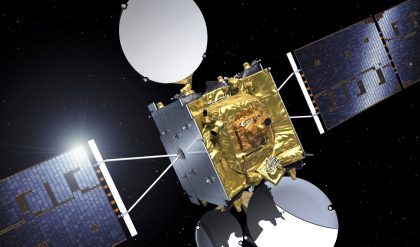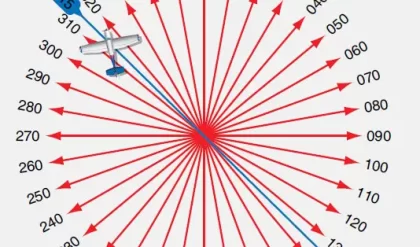Pneumatic gages have pressurized air exiting gage orifices. The air velocity differential or backpressure is a function of the separation of the gage and the part. In the direct or open jet method, the pressurized air experiences backpressure due to the impedances posed by the measured part. The typical scenario is that the gage head and the measured part have similar geometry (i.e., a cylindrical gage in a bored hole). By placing two gages on either side of a flat plate, the thickness may be inferred. In the indirect or contact method, the pressurized air pushes on a contact piece that directly contacts the part. Tolerances as small as 50 nm can be measured. (Vendors: Will rich Precision Instrument Co.; Moore Products Co.)
Optical: Focusing, Shadowing, Comparing
This includes microscopes, which can determine thickness either by comparison with a known reference, or by focusing on the front and rear surfaces of a sample, noting the difference in focus position. Comparators project onto a screen what might be noted through a microscope. Laser calipers retrieve dimensions by measuring the shadowing of a laser beam. (Vendors: NDC Systems for laser caliper; Scantron for laser profilometer.)
Weighing
Given a plate of material with known density, first measure the area with some type of calibrated video system. Then, a measurement of weight can be simply converted to an estimate of the thickness. As is common with this technique and most of the following techniques, estimating the thickness requires knowledge of some other property of the material to be measured — in this case, the density.
Capacitive Gaging
Capacitive gaging is realized by inserting a non-metallic material into a known electric field. Knowing the gage sensor area and the material’s dielectric constant, the thickness can be determined. Submicron thickness levels can be achieved. (Vendors: Ono Sokki; SolveTech.)
Inductive Gaging (Eddy Current Sensing)
The principle here is that ac currents in a coil induce eddy currents in a nearby conducting plate [4, 5]. These eddy currents can be sensed by a pickup coil, which may be the exciting coil or a second coil. The presence of the eddy currents manifests itself as a modification of the apparent inductance and/or the loss of the pickup coil. This technique is appropriate for nonferrous metals, and is especially sensitive to thickness variations due to flaws such as cracks or corrosion. There is one particular instance in which it is common to measure thickness rather than variations. That would be the thickness of a nonconducting coating on a nonferrous conducting substrate. The coating thickness creates a gap (lift-off) between the exciting coil and the eddy currents, thereby affecting the eddy current signal. The range of this technique would be about 1 mm. Fischer has an instrument designed for measuring the thickness of a newly laid road surface coating to a depth of 40 cm, by burying a conductive plate below the road. (Vendors: Fischer; deFelsko; CMI International.)
Magnetic Induction
This technique is also used to measure coating thickness, in this case a nonmagnetic coating on a ferromagnetic substrate. The nonmagnetic coating creates a gap (lift-off) between the ferromagnetic substrate and a probe. One way to measure the gap and thereby the thickness is by measuring the force required to pull away a magnetic probe. Another technique would be to magnetically couple the ferromagnetic substrate to a transformer core, with a gap between the substrate and the core. This technique would have a range of about 4 mm. CMI International has an informative brochure describing the relative merits of measuring coating thickness via eddy current, magnetic induction, beta-backscatter, microresistance, and X-ray fluorescence; the choice of technique depends, among other things, on the material to be tested. (Vendors: Fischer; CMI International; Electromatic; deFelsko.)
Hall Effect Gage
This sensor measures the thickness of nonferrous materials with 1% accuracy by sandwiching the material being measured between a magnetic probe on one side and a small target steel ball on the other side It measures up to 10 mm. The Hall effect sensor is used to measure the magnetic field, as a dc measurement; ac Hall effect measurements can be made more precisely because they eliminate bias and are done with less noise. (Vendor: Panametrics.)
Far-Field/Time-of-Flight: Ultrasound, Radar, Lidar
Using 1940s sonar principles and today’s microprocessor technology, high-frequency (1–20 MHz) ultrasound waves can be used to measure thickness by sending pulsed sound waves through a material and measuring the transit time of the reflected signal [5, 7]. Knowing the sound velocity of the material, materials from 0.5 mm to 250 mm can be measured, often as fine as 25 µm. Media include metal, glass, ceramic, liquid, rubber, fiberglass, plastic, and concrete. Ultrasound can also be used to measure living tissues, as is often done in the agricultural and medical fields. Fat layers of cattle and pigs can influence marketability. Skin burn depths can direct treatment procedures. The depth of foreign objects in the body is useful for microsurgery. Ultrasonic thickness determination has expanded to include multidimensional echolocation applications, such as imagery and acoustic microscopes that can resolve in the submicron level. The principles behind ultrasound also apply to electromagnetic waves. In the gigahertz range, this is called radar. Radar can be used to estimate the thickness of atmospheric layers such as cloud layers. The light-wave version of radar, called lidar, can be used to measure the thickness of water vapor layers in the lower atmosphere. (Ultrasonic vendors: KTa-Tator; deFelsko; Stresstel; Magnetic Analysis Corp.; Panametrics; Electromatic.)
Far-Field/Resonance: Ultrasound, Interferometry, Ellipsometry
The idea here is that when waves such as ultrasound impinge on a plane-parallel slab of material, there will be reflected power from both the front and rear surfaces; depending on whether the slab thickness is an odd or even number of quarter-wavelengths, the reflected beams will be in constructive or destructive interference. If the frequency is swept, the distance in frequency between successive maxima and minima may be related to the slab thickness, if the index of refraction is known. Since the natural, or resonant, modes of an object depend on the properties and dimensions of an object, knowledge of the properties enables estimation of dimensions from the resonant frequencies. Compared with time-of-flight ultrasound, resonant ultrasound is much less common. It has been used to characterize concrete, and is quite sensitive to flaws, as anyone who has heard a cracked bell would know. Resonant techniques are much more common with visible [8], infrared, or microwave [4] radiation. Spectral interferometry would be appropriate to characterize the thickness of transparent substrates with reasonably flat surfaces, sufficiently parallel to one another. A common way to do this would be to measure a transmission spectrum with a spectrometer such as a Fourier transform spectrometer (FTS). The successive maxima and minima are here called the Fabry–Perot effect, and their appearance in a spectrum is called channeling. Thickness can also be measured with spatial interferometry, which is essentially a way of measuring surface topography. An example would be the phenomenon of Newton’s rings, which occur when the surface to be tested is in contact with an optical flat. Using a transparent optical flat, transmit monochromatic light such as a mercury lamp through the flat and onto the interface between the flat and the test surface. If there are variations in the height of the test surface, then the two return beams from the optical flat and the test surface will alternate between constructive and destructive interference, producing fringes or rings. The sensitivity is not limited to the scale of the wavelength λ: with sufficient stability and signalto-noise, dimensions down to 1/1000 of a fringe can be measured. With sources of longer coherence length, such as lasers, the test surface and the optical flat need not be in direct contact. Another optical way to measure thickness is with ellipsometry [9], typically used to measure properties of thin, transparent films from a few tenths of nanometres to several hundreds of nanometres thick. This includes metals, as long as the metal is sufficiently thin to be partially transparent. By measuring the change in polarization state for nonmoral incidence light, both the thickness and refractive index of a thin layer may be inferred. Additional information (e.g., the properties of multiple layers) can be obtained by varying the angle of incidence and by observing at multiple wavelengths. The ability to estimate both thickness and refractive index is an important advantage of this technique, as often the refractive index of a material in thin film form is not the same as the bulk value, and indeed may be a property of the deposition conditions. (FTS vendors: Bomem; Digilab; Mattson; Midac; Nicolet; Perkin-Elmer. FTS system pricing may range from about $15,000 to over $100,000, depending on the application. Spatial interferometer vendors: Zygo; Wyko, Phase-Shift Technology. Ellipsometer vendors: J.A. Woollam Co., Inc.; Rudolf Instruments; Sentech. The cost of an ellipsometer may range from $10,000 for a manual, single-wavelength system to $200,000 for an automatic, multiwavelength system. Microwave resonance vendor: Hewlett-Packard.)
Far-Field/Absorption, Scattering, Emission: Beta, Gamma, X-Ray, Infrared
These techniques depend on the extinction (scattering or absorption) or emission of photons or massive particles (electrons, protons, neutrons) when transiting the material to be measured. Typically, the extinction or emission shows an exponential dependence on thickness; the dependence becomes linear if the absorption is sufficiently low. These techniques, in particular gamma-ray backscatter and beta-ray transmission, are used to measure continuously moving web materials (paper, metals, fabrics) on assembly lines. Infrared absorption is also suitable if the moisture content is controlled. Beta-backscatter and X-ray fluorescence [10] are used for measuring coatings. In X-ray fluorescence, upon exposure to X-rays, certain elements fluoresce (emit) X-rays at characteristic wavelengths. The strength of this emission is related to thickness. These absorption/emission techniques may sometimes be better suited than time of-flight ultrasound to the dimensional measurement of objects with complex shapes. (Gamma gage vendor; NDC Systems. X-ray absorption vendor: Measurex. X-ray fluorescence vendors: Fischer; NDC Systems; CMI International. Beta-backscatter vendor: Fischer; Electrometric; CMI International; Measurex. Infrared absorption vendor: NDC Systems. The prices for these systems will depend on the application; a typical system could cost $500,000.)
Destructive Techniques
Fischer markets a system that removes a coating into an electrolyte and then electrolytically deposits the removed coating. The electrical charge required for deposition is related to the coating thickness.





Comments are closed.